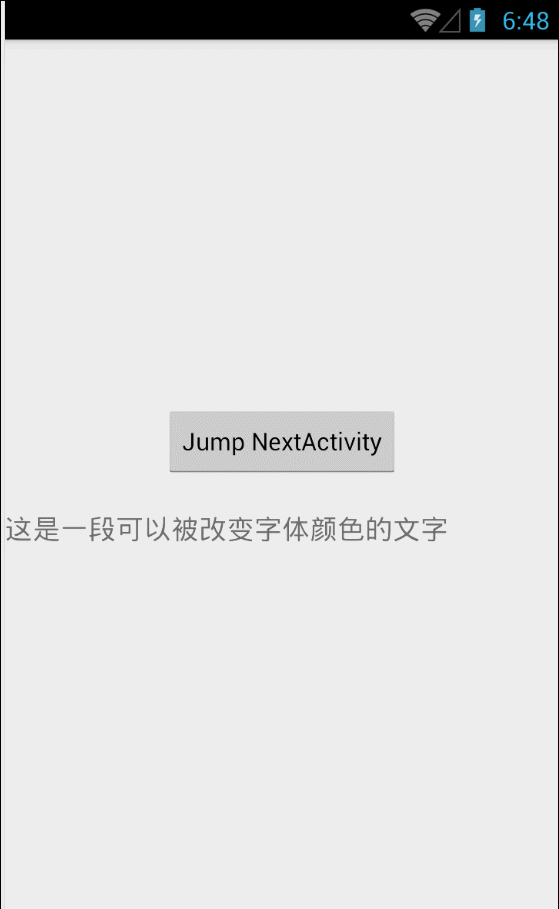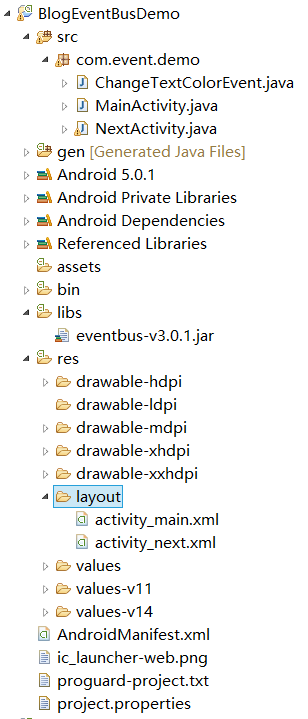1.EventBus优缺点
EventBus 作为 Android 开发中常用的框架,拥有着许多优点:
调度灵活。不依赖于 Context,使用时无需像广播一样关注 Context 的注入与传递。父类对于通知的监听和处理可以继承给子类,这对于简化代码至关重要;通知的优先级,能够保证 Subscriber 关注最重要的通知;粘滞事件(sticky events)能够保证通知不会因 Subscriber 的不在场而忽略。可继承、优先级、粘滞,是 EventBus 比之于广播、观察者等方式最大的优点,它们使得创建结构良好组织紧密的通知系统成为可能。
使用简单。EventBus 的 Subscriber 注册非常简单,调用 eventBus 对象的 register 方法即可,如果不想创建 eventBus 还可以直接调用静态方法 EventBus.getDefault() 获取默认实例,Subscriber 接收到通知之后的操作放在 onEvent 方法里就行了。成为 Publisher 的过程就更简单了,只需要调用合适的 eventBus(自己创建的或是默认的)的 post 方法即可。
快速且轻量。作为 github 的明星项目之一, EventBus 的源代码中许多技巧来改善性能;
- eventbus的 缺点是他的代码逻辑不是很清楚,在 Subscriber 注册的时候,Subscriber 中的方法会被遍历查找以 onEvent 开头的 public 方法。这将带来一些问题,一旦对代码进行混淆,就无法查找到了。好消息是 EventBus 已经打算使用注解来实现,这应该能够解决代码混淆的问题。
但有一个缺点是观察者独有的,那就是观察者可能会造成接口的膨胀。特别是当程序要求大量形式各异的通知,而程序员有没有做出良好的抽象时,代码中会包含大量的接口,接口数量的增长又会带来命名、注释等等一大堆问题。本质上说观察者要求程序员从零开始实现事件的产生、分发与处理过程,这就要求参与者必须对整个通知过程有着良好的理解。当程序代码适量时,这是一个合理的要求,然而当程序太大时,这将成为一种负担。
下面我们实现这一一个效果,A页面跳转到B页面,B页面发送通知更新A页面的textView的字体颜色(颜色值随机),效果图如下:
2.项目结构
3.activity_main.xml
放了一个按钮和一个显示文字的TextView,跳转到nextactivity的按钮
<LinearLayout xmlns:android="http://schemas.android.com/apk/res/android"
xmlns:tools="http://schemas.android.com/tools"
android:layout_width="match_parent"
android:layout_height="match_parent"
android:orientation="vertical"
android:gravity="center"
tools:context="${relativePackage}.${activityClass}" >
<Button
android:id="@+id/btn"
android:layout_width="wrap_content"
android:layout_height="wrap_content"
android:textSize="16sp"
android:text="Jump NextActivity" />
<TextView
android:id="@+id/color_text"
android:layout_width="match_parent"
android:layout_height="wrap_content"
android:layout_marginTop="20dp"
android:textSize="18sp"
android:text="这是一段可以被改变字体颜色的文字"
/>
</LinearLayout>
4.ChangeTextColorEvent.java
定义事件类,获取颜色和当前的activity
/**
*
* <改变颜色的Event>
*
* @author wangkeke
* @version [V1.00, 2016年5月10日]
* @see [相关类/方法]
* @since V1.00
*/
public class ChangeTextColorEvent
{
private String color;
private Activity activity;
public ChangeTextColorEvent(String color, Activity activity)
{
super();
this.color = color;
this.activity = activity;
}
public String getColor()
{
return color;
}
public Activity getActivity()
{
return activity;
}
}5.MainActivity.java
代码非常简单,注册EventBus,反注册EventBus,onEventMainThread用于接收订阅的事件
public class MainActivity extends Activity
{
private Button button;
private TextView textView;
@Override
protected void onCreate(Bundle savedInstanceState)
{
super.onCreate(savedInstanceState);
setContentView(R.layout.activity_main);
//注册EventBus
EventBus.getDefault().register(this);
initView();
}
private void initView()
{
button = (Button)findViewById(R.id.btn);
textView = (TextView)findViewById(R.id.color_text);
button.setOnClickListener(new OnClickListener()
{
@Override
public void onClick(View v)
{
//跳转到NextActivity
Intent intent = new Intent(MainActivity.this, NextActivity.class);
startActivity(intent);
}
});
}
/**
* public修饰,不能使用static abstart修饰
* 参数只能有一个
* @param event
* @see [类、类#方法、类#成员]
*/
@Subscribe
public void onEventMainThread(ChangeTextColorEvent event)
{
textView.setTextColor(Color.parseColor(event.getColor()));
//finish NextActivity
event.getActivity().finish();
}
@Override
protected void onDestroy()
{
super.onDestroy();
//反注册EventBus
EventBus.getDefault().unregister(this);
}
}6.activity_next.xml
定义一个发送消息的按钮
<RelativeLayout xmlns:android="http://schemas.android.com/apk/res/android"
xmlns:tools="http://schemas.android.com/tools"
android:layout_width="match_parent"
android:layout_height="match_parent"
tools:context="${relativePackage}.${activityClass}" >
<Button
android:id="@+id/button"
android:layout_width="wrap_content"
android:layout_height="wrap_content"
android:layout_centerInParent="true"
android:textSize="16sp"
android:text="发送改变字体颜色的Event" />
</RelativeLayout>7.NextActivity.java
public class NextActivity extends Activity
{
private Button button;
@Override
protected void onCreate(Bundle savedInstanceState)
{
super.onCreate(savedInstanceState);
setContentView(R.layout.activity_next);
initView();
}
private void initView()
{
button = (Button)findViewById(R.id.button);
button.setOnClickListener(new OnClickListener()
{
@Override
public void onClick(View v)
{
Toast.makeText(NextActivity.this, getRandColorCode(), Toast.LENGTH_SHORT).show();
//发送消息
EventBus.getDefault().post(new ChangeTextColorEvent(getRandColorCode(), NextActivity.this));
}
});
}
/**
* 获取十六进制的颜色代码.例如 "#6E36B4"
*
* @return String
*/
public static String getRandColorCode()
{
String r, g, b;
Random random = new Random();
r = Integer.toHexString(random.nextInt(256)).toUpperCase();
g = Integer.toHexString(random.nextInt(256)).toUpperCase();
b = Integer.toHexString(random.nextInt(256)).toUpperCase();
r = r.length() == 1 ? "0" + r : r;
g = g.length() == 1 ? "0" + g : g;
b = b.length() == 1 ? "0" + b : b;
return "#"+r + g + b;
}
}8.接收函数
EventBus除了可以使用onEventMainThread()函数接收之外,其实EventBus还有另外几个不同的函数,他们分别是:
1、onEvent
2、onEventMainThread
3、onEventBackgroundThread
4、onEventAsync
四种订阅函数都是使用onEvent开头的,它们的功能稍有不同,在介绍不同之前先介绍两个概念:
告知观察者事件发生时通过EventBus.post函数实现,这个过程叫做事件的发布,观察者被告知事件发生叫做事件的接收,是通过下面的订阅函数实现的。
- onEvent:如果使用onEvent作为订阅函数,那么该事件在哪个线程发布出来的,onEvent就会在这个线程中运行,也就是说发布事件和接收事件线程在同一个线程。使用这个方法时,在onEvent方法中不能执行耗时操作,如果执行耗时操作容易导致事件分发延迟。
- onEventMainThread:如果使用onEventMainThread作为订阅函数,那么不论事件是在哪个线程中发布出来的,onEventMainThread都会在UI线程中执行,接收事件就会在UI线程中运行,这个在Android中是非常有用的,因为在Android中只能在UI线程中跟新UI,所以在onEvnetMainThread方法中是不能执行耗时操作的。
- onEventBackground:如果使用onEventBackgrond作为订阅函数,那么如果事件是在UI线程中发布出来的,那么onEventBackground就会在子线程中运行,如果事件本来就是子线程中发布出来的,那么onEventBackground函数直接在该子线程中执行。
- onEventAsync:使用这个函数作为订阅函数,那么无论事件在哪个线程发布,都会创建新的子线程在执行onEventAsync.
备注:
参考文章:























 709
709











 被折叠的 条评论
为什么被折叠?
被折叠的 条评论
为什么被折叠?








